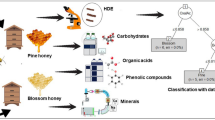Abstract
Manuka honey from New Zealand is derived from the nectar of Leptospermum scoparium and contains high amounts of methylglyoxal (MGO), which is responsible for its extraordinary antibacterial properties and its high market value. It was shown recently, that honeys from Australian Leptospermum species, often referred to as “jellybush honey”, also contain MGO. Recently, an official method has been published by the Ministry of Primary Industries (MPI) New Zealand to characterize monofloral and multifloral manuka honey from New Zealand, based on the concentration of the phytochemical compounds 2′-methoxyacetophenone (2-MAP), 2-methoxybenzoic acid (2-MB), 3-phenyllactic acid (3-PLA) and 4-hydroxyphenyllactic acid (4-HPLA). Here we show that these phytochemical markers are suitable to differentiate honeys originating from Leptospermum species from New Zealand or Australia, respectively. Three non-manuka honeys and eight manuka honeys from New Zealand as well as four non-Leptospermum honeys and 15 Leptospermum honeys from Australia were analysed for their MGO content via RP-HPLC-UV and their 2-MAP, 2-MB, 4-HPLA and 3-PLA concentration via RP-HPLC–MS/MS. All non-manuka honeys contained only negligible amounts of MGO, whereas honeys from Leptospermum species contained up to 1100 mg/kg, independent of the geographical origin. No significant amounts of 3-PLA, 4-HPLA, 2-MB and 2-MAP were found in the non-manuka honeys. In contrast, all marker compounds were abundantly present in manuka honeys from New Zealand, thus enabling a characterization of monofloral or multifloral quality. All honey samples from Australian Leptospermum species contained 2-MAP in concentrations below the limit of detection. The concentrations of the other marker compounds ranged from 58 to 357 mg/kg for 3-PLA, from 1 to 3 mg/kg for 4-HPLA and from 26 to 175 mg/kg for 2-MB and were significantly different when compared to New Zealand manuka honeys. Based on the results of this study, the marker compounds suggested by the MPI might be useful to distinguish honeys derived from Leptospermum species of different geographical origins.




Similar content being viewed by others
Abbreviations
- 4-HPLA:
-
4-Hydroxyphenyllactic acid
- 3-PLA:
-
3-Phenyllactic acid
- 2-MB:
-
2-Methoxybenzoic acid
- 2-MAP:
-
2′-Methoxyacetophenone
- NLH:
-
Non-Leptospermum honeys
- MGO:
-
Methylglyoxal
- LOD:
-
Limit of detection
- LOQ:
-
Limit of quantification
- MRM:
-
Multiple reaction monitoring
- MPI:
-
Ministry of Primary Industries
References
Mavric E, Wittmann S, Barth G, Henle T (2008) Identification and quantification of methylglyoxal as the dominant antibacterial constituent of Manuka (Leptospermum scoparium) honeys from New Zealand. Mol Nutr Food Res 52:483–489
Atrott J, Haberlau S, Henle T (2012) Studies on the formation of methylglyoxal from dihydroxyacetone in Manuka (Leptospermum scoparium) honey. Carbohydr Res 361:7–11
Adams CJ, Manley-Harris M, Molan PC (2009) The origin of methylglyoxal in New Zealand manuka (Leptospermum scoparium) honey. Carbohydr Res 344:1050–1053
Williams S, King J, Revell M et al (2014) Regional, annual, and individual variations in the dihydroxyacetone content of the nectar of manuka (Leptospermum scoparium) in New Zealand. J Agric Food Chem 62:10332–10340
Norton AM, Mckenzie LN, Brooks PR, Pappalardo LJ (2015) Quantitation of dihydroxyacetone in Australian Leptospermum nectar via high-performance liquid chromatography. J Agric Food Chem 63:6513–6517
Windsor S, Pappalardo M, Brooks P et al (2012) A convenient new analysis of dihydroxyacetone and methylglyoxal applied to Australian Leptospermum honeys. J Pharmacogn Phyther 4:6–11
Cokcetin NN, Pappalardo M, Campbell LT et al (2016) The antibacterial activity of Australian Leptospermum honey correlates with methylglyoxal levels. PLoS One 11:1–13
Wrigley JW, Fagg M (2007) Australian native plants—cultivation, use in landscaping and propagation. New Holland Publishers, Sydney
Thompson J (1989) A revision of the genus leptospermum (Myrtaceae). Telopea 3:301–448
Stephens JMC, Molan PC, Clarkson BD (2005) A review of Leptospermum scoparium (Myrtaceae) in New Zealand. New Zeal J Bot 43:431–449
Price JN, Morgan JW (2006) Variability in plant fitness influences range expansion of Leptospermum scoparium. Ecography 4:623–631
Ministry for Primary Industries (2015) Apiculture monitoring report, pp 1–12
Oelschlaegel S, Gruner M, Wang P-N et al (2012) Classification and characterization of manuka honeys based on phenolic compounds and methylglyoxal. J Agric Food Chem 60:7229–7237
Kato Y, Umeda N, Maeda A et al (2012) Identification of a novel glycoside, leptosin, as a chemical marker of manuka honey. J Agric Food Chem 60:3418–3423
Beitlich N, Koelling-Speer I, Oelschlaegel S, Speer K (2014) Differentiation of Manuka Honey from Kanuka Honey and from Jelly Bush Honey using HS-SPME-GC/MS and UHPLC-PDA-MS/MS. J Agric Food Chem 62:6435–6444
Spiteri M, Rogers KM, Jamin E et al (2017) Combination of 1H NMR and chemometrics to discriminate manuka honey from other floral honey types from Oceania. Food Chem 217:766–772
Ministry for Primary Industries (2017) Criteria for identifying mānuka honey: a summary of the mānuka honey science programme. https://www.mpi.govt.nz/dmsdocument/17314-criteria-for-identifying-manuka-honeysummary-report
Irish J, Blair S, Carter D (2011) The antibacterial activity of honey derived from Australian flora. PLoS One 6:e18229
Roshan N, Rippers T, Locher C, Hammer KA (2016) Antibacterial activity and chemical characteristics of several Western Australian honeys compared to manuka honey and pasture honey. Arch Microbiol 199:347–355
Ministry for Primary Industries (2017) Determination of four chemical characterisation compounds in honey by liquid chromatography tandem mass spectrometry (LC-MS/MS). https://www.mpi.govt.nz/dmsdocument/17347-determination-of-four-chemical-characterisation-compounds-in-honey-by-liquidchromatography-tandem-mass-spectrometry-lc-msms
Bong J, Loomes KM, Lin B, Stephens JM (2017) New approach: chemical and fluorescence profiling of NZ honeys. Food Chem. In Press. https://doi.org/10.1016/j.foodchem.2017.07.065
Author information
Authors and Affiliations
Corresponding author
Ethics declarations
Conflict of interest
The authors declare no competing financial interest.
Rights and permissions
About this article
Cite this article
Rückriemen, J., Henle, T. Pilot study on the discrimination of commercial Leptospermum honeys from New Zealand and Australia by HPLC–MS/MS analysis. Eur Food Res Technol 244, 1203–1209 (2018). https://doi.org/10.1007/s00217-018-3036-1
Received:
Revised:
Accepted:
Published:
Issue Date:
DOI: https://doi.org/10.1007/s00217-018-3036-1




